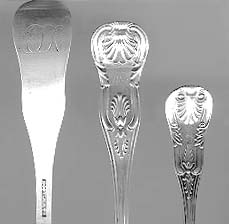|
|
The Collecting Place Settings Forum The forum's posts/subject/threads are closed.
This forum can only be viewed |
|
How to Post Photos
Want to be a Moderator?
|
|
|
The Collecting Place Settings Forum The forum's posts/subject/threads are closed.
This forum can only be viewed |
|
How to Post Photos
Want to be a Moderator?
|

|
 SMP Silver Salon Forums SMP Silver Salon Forums
  Collecting Place Settings Collecting Place Settings
  Early American Coin Kings Early American Coin Kings
|
| next newest topic | next oldest topic |
| Author | Topic: Early American Coin Kings |
|
Bob Schulhof Posts: 194 |
  
Early American Coin Kings  Special Features In the US Kirk Kings has lasted since 1832 as a single struck pattern but most of the early makes have come and gone. The ends of the spoon handles continue the turned up/turned down debate and we have both in our collection. Dating In the set below we have :
Pieces Available (L to R) Would be interested in opinions regarding the third fork. Is it a very early salad for or just pastry? Outside tine definitely used for cutting. Photo: Key Pieces Comments In what circumstances were the pieces placed point up and when point down? (See discussion re British Hanoverian and Old English on this topic) IP: Logged |
All times are ET | next newest topic | next oldest topic |
  |
|
Ultimate Bulletin Board 5.46a
|
copyright © 1993-2022
SM Publications
All Rights Reserved. Legal & Privacy Notices |